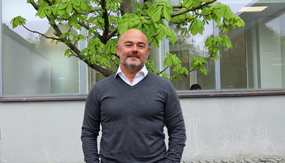
Aurelio Politano. © Katja Lepistö
Communications and effectiveness go hand in hand. Effective communication is being considered especially now that the EU LIFE project Circwaste, which promotes a circular economy and a national waste plan, is nearing its completion.
The promising results of the Circwaste pilot projects show that achieving declining recycling targets is possible - if only the solutions found are available everywhere. In many pilot projects, communication has been one of the main keys to success. Communications and effectiveness were also discussed in the monitoring session of the project.
In May, Aurelio Politano, a Senior Project Advisor from CINEA (The European Climate, Environment and Infrastructure Executive Agency), an EU representative, also took part in the annual audit of our EU Life project. From the beginning of the project, Politano has been the official inspector and liaison for the EU Commission. We asked for his views on the impact of our project so far.
Circwaste has achieved many successes
“The project has done very well so far. In spite of its complexity and scale we seem to have reached the time to ‘harvest’ the fruits of all the good seeds you have planted in these years”, says Politano.
According to him, the lasts months of implementation, until the end of 2023, will be crucial to consolidate the many and significant results achieved and to make sure that a proper visibility is given both at national but also European level.
“Some of the work done in supporting the regions to adopt regional circular economy roadmaps, the contribution given to the recently published new National Waste Plan as well as the innovative work on setting up innovative CE indicators are only few examples of the great achievements you have reached so far”, continues Politano.
The final year of the project is crucial
Politano gives important advice for Circwaste project that is about to start its’ final year:
- Strategically, you should sit down and make sure you extract the key highlights and successes of the project. In such a complex project this is key to make sure such results can be properly shared, communicated and used also by other Member States.
- Secondly, make sure you pay attention and plan the continuation of the project. You have implemented and still are implementing so many relevant actions and for all of them you should ask yourself how all this good work will continue after the project ends.
- Thirdly, a crucial part of a project like yours, from the European Commission perspective, is policy feedback. There are many relevant issues that you have faced from this point of view in all these years, and I would be glad to feed them back to the relevant units of our parent DG of the Commission.
- Lastly, impacts! As you know in the LIFE programme, we are obsessed by KPIs (key performance indicator)! We want to know not only what the project was able to achieve in terms of knowledge creation but also its impacts on the ground, so a proper reporting in the Final report and in the KPI database is crucial for us.
LIFE IP projects support the implementation of key environmental strategies in Europe
Differently from LIFE traditional projects the LIFE IPs were designed with a very specific objective in mind: the idea of catalysing the full implementation at national or regional level of certain key plans and strategies required under EU legislation (e.g.: National waste management plans but also others).
From this point of view, the key target of an IP project is the degree of contribution to such implementation. Such contribution of IP varies a lot in the different Member States and it also depends on the ambition of the IP project.
“In some cases, it consists of some ‘hardcore’ implementation linked, for example, to national recycling infrastructure, while in some other cases, like Circwaste project, it is more about a strategic contribution in terms of knowledge and policy. However, we can say that LIFE IPs have proved to be a very useful instrument, and this is also why they also feature in the new LIFE programme 2021–2027 with some slightly revised features. They are now called Strategic Integrated Projects”, says Politano.
LIFE Programme 30th anniversary #LIFEis30
On 21 May 2022 the LIFE programme turned thirty. Since 1992 LIFE has funded over 5.500 projects in different areas related to environmental protection, nature conservation and climate action, including renewables and energy efficiency. This important landmark is being celebrated with events around Europe, comprising several commemorative activities and initiatives that will be carried out directly by LIFE projects beneficiaries. The website www.lifeis30.eu offers an overview of such events as well as a set of useful documents that can support those who wants to join the celebrations. This year, LIFE has also launched an Instagram account, so don’t forget to check it out.
CIRCWASTE is a seven-year LIFE IP project that promotes efficient use of material flows, waste prevention and new waste and resource management concepts. The project is implemented during the years 2016–2023. All actions contribute to implementing the national waste management plan and directing Finland towards a circular economy. CIRCWASTE is a creation of 20 partners and 10 funding organisations. The project is coordinated by the Finnish Environment Institute. CIRCWASTE is funded in large part by the EU LIFE programme.